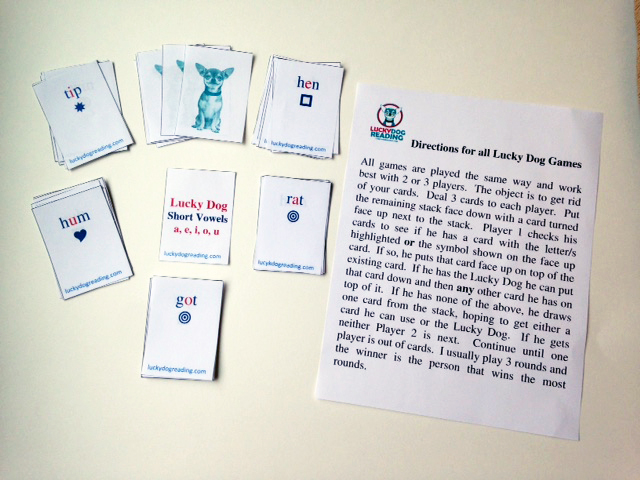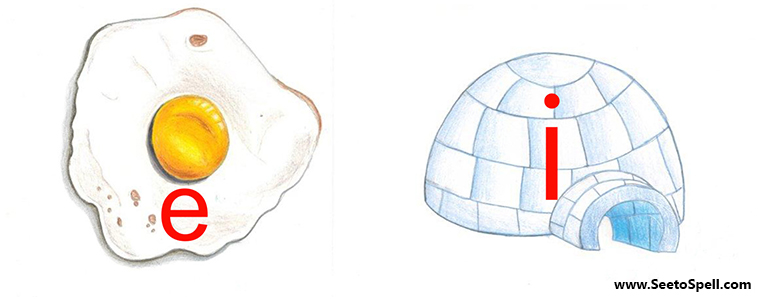It’s pretty common for people to mix up the short e (sounds like “eh”) and the short i (sounds like “ih”) in our culture. The word pen can sound a lot like pin, for example.
Here are a few simple steps to help your student tell the difference between the two vowel sounds. You’ll begin by helping them first pronounce the vowel correctly and only then move on to spelling the vowel correctly.
To do that, you’ll help them both see and hear the differences between the vowel sounds.
Review the keyword picture cards with your dyslexic student
Help your student pronounce the vowels sounds using keyword picture cards. You can use the keyword cards provided or have your student make their own. A keyword picture card has an illustration of a word that corresponds to the sound of the letter you’re working on. It provides a memory anchor that links an image to the word and to the sound of the letter in the word. Combining letters and words with pictures, songs, or story helps to speed the learning process.
Click here to open and print out the egg keyword picture card
Click here to open and print out the igloo keyword picture card
Practice hearing the sounds
In this step, you’ll help your student practice hearing the correct sound of the vowels. You can start with the words in the list we provide here. When you go over the list, you should exaggerate and elongate the sound of the vowel in each word. Take your time so you make the sound clearly and so your learner can really hear it.
Have student watch your mouth
Have your student literally watch your mouth move differently as you pronounce the short i and the short e sounds. For example, they might notice that your chin drops a little more for the short e sound and your mouth forms into a straight line smile for the short i.
Have student look in the mirror
Have your student practice making these sounds in the mirror and make mental notes about what they do differently for each vowel.
Learn the sounds with games
Once your student has mastered the sounds of the alphabet, it can be helpful to use a simple phonics game to review the vowel sounds in simple 3-letter CVC (consonant/vowel/consonant) words.
We like the Lucky Dog Short Vowel Game to practice with. It is one of the free games you can find on teacherspayteachers.com. You can use the Lucky Dog Short Vowel Game cards as flashcards or you can follow the directions and play the game!

Click here to open and print out the Lucky Dog Short Vowel Game (It’s best to print the game on a color printer using card stock.)
Click here to open and print out the Lucky Dog Short Vowel Game instructions
When playing the game, bring in the egg and igloo keyword picture cards. If the game card has the vowel your student is working on, have them say the word in the keyword picture card out loud (“egg”), then make the vowel sound (“eh”) and then read the word on the game card. The repetition makes a huge difference so have them do it over and over!
You can find more CVC games (games to help people learn words in the form of consonant-vowel-consonant — CVC) online. We like the free or inexpensive CVC games at teacherspayteachers.com. To get the games, you have to first create your free account and then access the inexpensive resources.
Practice spelling with a list of words
Use the list of CVC words to practice with. Select a word at a time and speak the word for your student, elongating the vowel sound to make it very clear. Test them with pairs of words that differ only in the vowel used, like pit and pet.
In the beginning, avoid words ending with m or n
People have the most trouble differentiating between the sound of a spoken e or i when it’s followed by nasal-y consonants like m and n. That makes spelling those words even that much harder. So, when you’re just getting started, avoid words ending with m or n until your student has mastered the rest of the words.
Then tackle words ending with m and n
Once your student has graduated from learning simpler words, have them try their skills out on 3-letter words ending with m and n. Once they’ve mastered those, they can move on to words with more than three letters, like hint, pant and limp.
Click here to print out a short list of words ending in m and n
More spelling help
Here are a few other spelling strategies that help your student memorize words. Have fun with them and repeat as much as you can!
- Spell the word out loud
- Write the word with its vowel in red
- Spell the word in the air using large arm movements
- Spell the word on a table using the index finger and middle finger
- Trace the word using the wrong end of pencil
- While your student is spelling a word, have him lightly tap his arm once for each letter in the word, moving closer and closer to his hand. Then have him read the word one more time and at the same time, slide his hand from the opposite shoulder to wrist. Repeat two more times.
Repetition is important. But have fun too!
Learning to spell words with the short e and i sounds takes time and practice. But the more we incorporate a variety of senses — eyes, ears, touch — the more the brain is engaged, and the more neural pathways are created to build memory traces. Turn the learning into fun, do it repeatedly, and you’ll be pleased with your results!
See to Spell is on a mission to find real learning solutions for people diagnosed with dyslexia, ADHD and other learning struggles. Let us know how we can help you!
Discover See to Spell Sight Words flashcards, a fun spelling tool to learn sight words that uses color, meaning, humor, story, and images to greatly improve memory retention – and make learning so much more fun!



